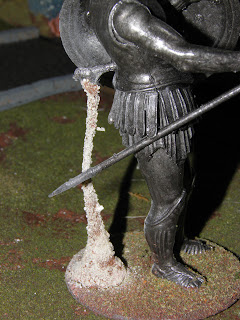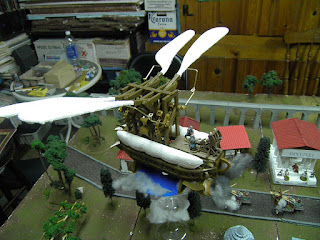
I am going to be running two games at Historicon in July. One is actually a very silly recreation of the barricade scene in Les Miserables that I’ll post some details on at a different time.
The other is the following:
Title: Res Mechanica: The Long But Single Year – Rome 69 AD
Rules:Astounding Tales/All God's Children Got Guns
Scale: 28mm
Day: Friday
Time: 7:00pm
Duration: 4 hours
Players: 8
Description: Archimedes wasn't killed, the Library of Alexandria didn't burn so technology in the Roman Empire grew at unprecedented rates. Being good Romans, they devoted these wonders to two things: warfare and entertainment. So when Roman turned upon Roman in the Year of the Four Emperors, they had some interesting tools to help slaughter one another. Weird Science Romans, featuring Hieronian steam engines and automata, Archimedean heat rays, winged Icarans, land galleys, and Nero's water organ.
The scenario will be the battle for the Capitoline Hill late in the Year of the Four Emperors. Historically, after the defeat of the Emperor Vitellius’ army at the 2nd Battle of Cremona, Vespasian’s brother Flavius Sabinus who was the City Prefect of Rome attempted to negotiate an abdication by Vitellius. When this failed due to the refusal of Vitellius’ supporters, Sabinus, Vespasian’s son Domitian, and their followers including some of the Urban Cohorts barricaded themselves on the Capitoline Hill. A Flavian cavalry force under Petilius Cerialis attempted a rescue but were defeated and the Hill was stormed. During the fighting, the Temple of Jupiter, one of the holiest sites in Rome, was burned. Sabinus was killed but Domitian was able to escape in disguise. A short time later, the Flavian army stormed Rome and Vitellius was killed.
I always thought this would make an interesting scenario. I’ve also been fascinated by the invention described by Hiero of Alexandria and so decided to add some fantastical “weird science” elements to this fight. In a later post, I’ll show some of the weird science models but for now I wanted to post the scenery I did for the game. This is still a work in progress and I have some details to work out.
Half of the board will be a much reduced impression of the city of Rome while the other half will be the more open countryside beyond the walls.


My normal gaming table is only about 6' by 4' while the cloth I use for conventions is 6' x 8' To check a full set up I usually set things up on my living room or basement floor.
Here's the Temple of Jupiter and its interior


One of the gates of Rome:

The Basilica Aemilia:

The Theater of Marcellus:

The Forum:


A back street:

As is obvious, this is not any attempt to create and accurate or detailed model of the city or the various buildings, nor are they particularly good models in and of themselves. The main virtue is that it was very cheap to create the city. Most of this is scratch built from scrap beaded styrofoam and a few foam boards with a couple of middle-eastern buildings from Game Craft that I modified a bit. There's only one resin model of a temple - I forget the manufacturer - serving as the Temple of Juno Moneta. I also used plastic figures of various scale and manufacture for the statuary.
































